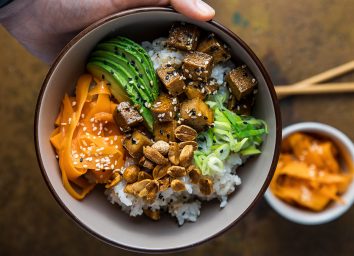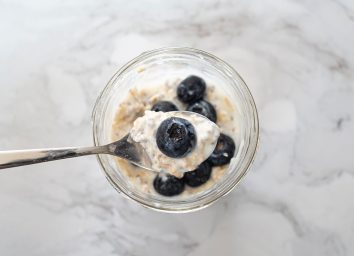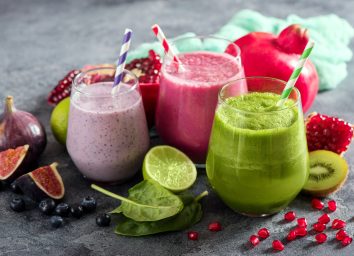The 21 Best Weight Loss Tips of 2021, According to Experts
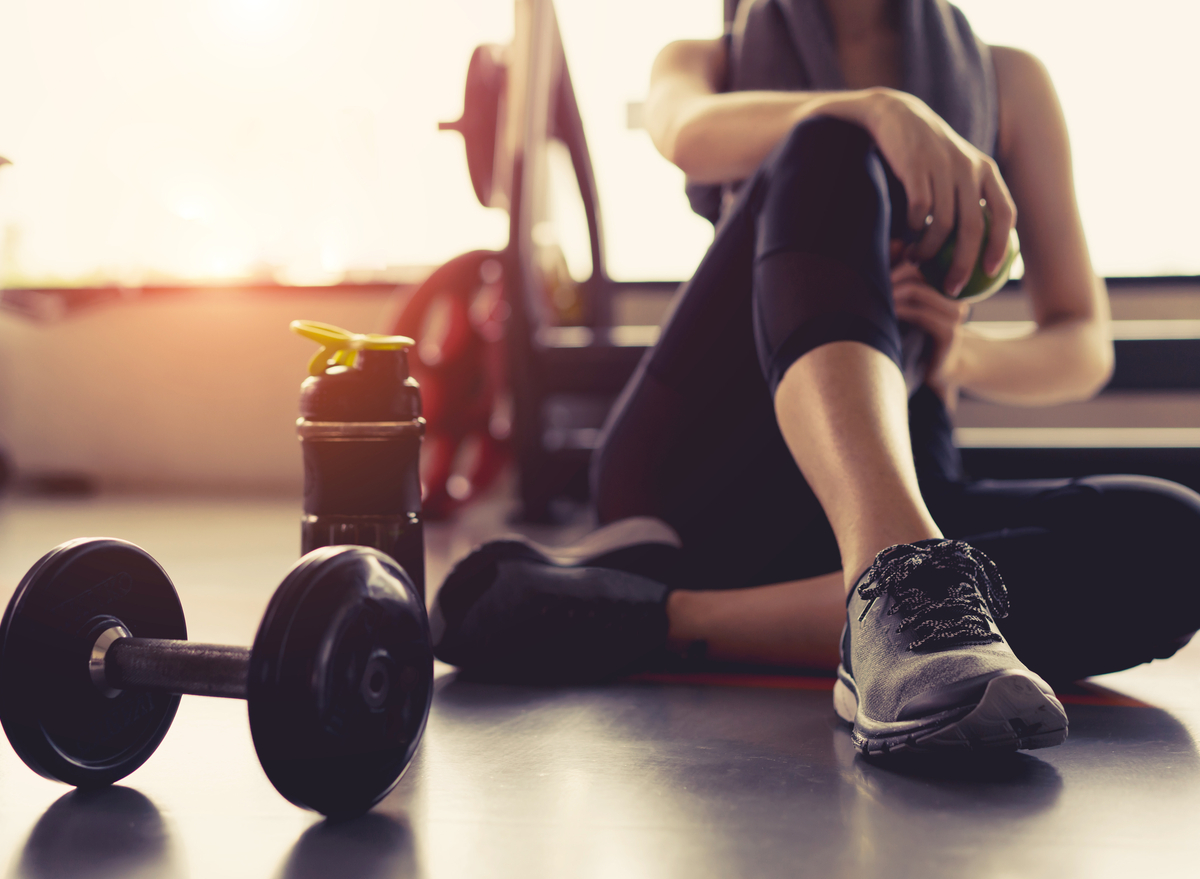
Going into 2021, experts say many people are more committed than ever to their goals. And is that any surprise? With gyms closing down and the “quarantine 15” becoming an inevitable reality thanks to working from home with access to an endless array of snacks, 2020 was a tough year for weight loss.
Now, many are downloading apps to help with calorie or macro tracking, investing in state-of-the-art home gym equipment to stay fit without leaving the house, trying new and more sustainable diets, and working with dietitians and nutritionists to personalize their plans. And experts say it’s the perfect time to take stock of your efforts—to reflect on what worked for you and what didn’t as you draw up those weight-loss resolutions for 2022.
“With all the trauma the pandemic has brought, it’s also given people the opportunity to think about their desires and priorities,” says Jill Weisenberger, MS, RDN, author of the free guide Change Your Habits & Ditch Restrictive Eating. “I think more people are approaching weight loss from a health viewpoint now instead of a cosmetic viewpoint. The health lens likely means slower weight loss for many people, but it also probably means more lasting weight loss. Instead of chasing numbers on the scale, people are approaching their weight as just one important part of their overall health.”
According to Silvia Carli, MS, RD, the lead nutritionist with 1AND1 LIFE, the one approach to ditch going into 2022 is fad diets that are too restrictive to be sustainable.
“We now understand that thinner does not necessarily equal healthier,” says Marissa Meshulam, RD, founder of MPM Nutrition. “Different bodies are meant to be different sizes and we should shift the focus more towards our individual health, what foods and activities feel good in our bodies and away from the scale.”
With all that in mind, we rounded up the best weight loss tips of 2021 from dietitians, doctors, and personal trainers, so you can work toward a healthier, more confident you in 2022.
Have protein at every meal.
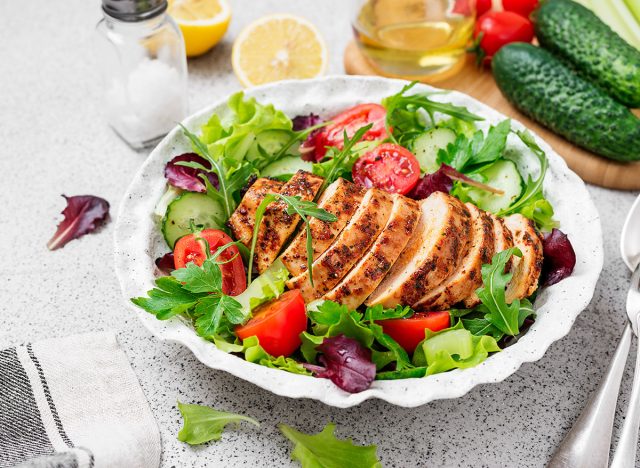
Across the board, experts agree that eating enough protein is a crucial nutrient for weight loss, not only because it keeps you feeling satiated but because your body burns more calories metabolizing this macronutrient than it does for carbs or fat.
“One of the best things to help people manage their appetite is to spread their protein out fairly evenly over three meals,” says Weisenberger. “I recommend about 25 grams of protein at each meal because protein helps with satiety. And, equally important, it’s needed to stimulate muscle synthesis.”
During weight loss, it’s very easy to lose muscle along with fat, adds Weisenberger. Eating adequate protein can help to prevent this from happening—and that’s important since muscle burns more calories than fat tissue.
Here are Ways Eating Protein Can Help You Lose Weight, Say Dietitians.
Stick with calorie-free drinks.

Water, unsweetened tea, flavored seltzer—these are the kinds of beverages that experts advise focusing on when you want to trim down. Alcoholic drinks, juices, and sugary coffee drinks can totally sabotage your weight loss efforts without even contributing many nutrients or helping you feel full.
Amelia Brown, RD with Redwood Reserves, says minimizing your alcohol consumption, in particular, is imperative to losing weight. If giving up drinking cold turkey is too challenging, she advises only allowing yourself to drink on weekends and limiting yourself to one or two.
“Only consume drinks that have no calories in them,” says TJ Mentus, ACE-certified personal trainer and member of the expert review board at Garage Gym Reviews. “If you are consuming drinks with added sugars it is an easy way to unintentionally get into a surplus of calories. These calories will not satiate hunger like whole foods will so you will end up still having to eat real food. By cutting out these drinks you can easily save a couple of hundred calories a day if not more depending on what your current consumption looks—like which can translate to a half-pound of weight loss a week at least.”
Morgyn Clair, MS, RDN, author at Fit Healthy Momma, says upping your water intake is a stellar strategy for weight loss. She recommends drinking at least 64 ounces a day—and more if you’re super active.
“Not only is water calorie-free, but it can help your body regulate hunger and fullness cues,” she explains. “Oftentimes when the body is thirsty, it manifests as hunger. Staying hydrated can help you to say no to unhealthy snacking habits.”
Eat more high-quality protein.
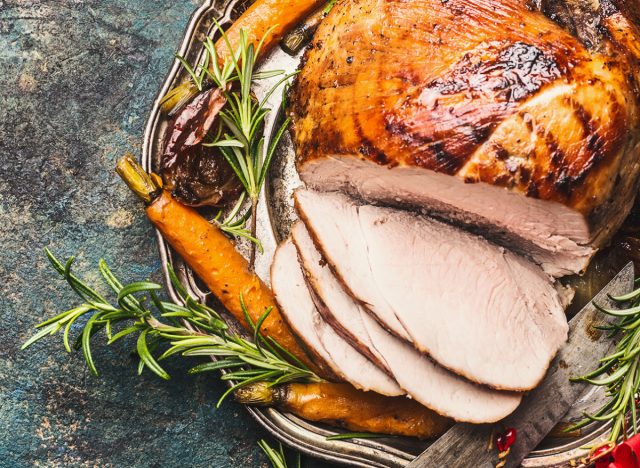
“I can’t stress enough how important it is to consume the right amount of high-quality protein each day,” says Carli.
If you’re looking to lose weight, Carli recommends consuming 1.2 to 2 grams of protein per kilogram of body weight per day. For example, the daily protein intake for a 155-pound person should be between 85 and 140 grams of protein per day.
“Many people make the mistake of moving into healthy eating by only paying attention to lowering carbs, but it is essential to include enough protein to help keep the metabolism going,” says Carli.
But not all protein sources are created equal—a fatty cut of beef, for instance, is a less healthy protein choice for weight loss than a serving of shrimp, which is packed with protein and essential minerals but very low in fat.
“High-quality proteins are lean meats like chicken, turkey, lean beef cuts, eggs, low-fat dairy, and plant sources like tofu, tempeh, edamame,” says Carli.
Make losing weight convenient.
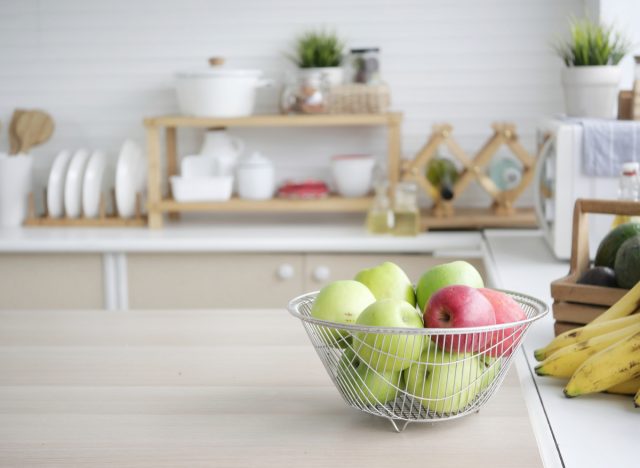
If you join a gym that’s a 30-minute drive away, you’re way less likely to stick with a regular routine than if you find one that’s right around the block. If you pack healthier snacks for work, you’re less likely to hit up the office vending machine for candy or a bag of chips.
“Willpower is limited,” explains Weisenberger. “It shrinks as the day goes on and as we get busy, frustrated, or tired. So ask yourself, ‘how can I make this easy?'”
Here are some examples of how Weisenberger suggests making weight loss more convenient:
- Keeping a bowl of fruit on the counter where it’s visible
- Keeping a pair of walking shoes at work
- Laying out your morning workout clothes the night before
- Keeping indulgences on a high shelf where they’re out of sight (and therefore out of mind)
Here are a few other Tiny Eating Tweaks That Make a Huge Weight Loss Difference Over Time.
Try the 3-2-1 training method.
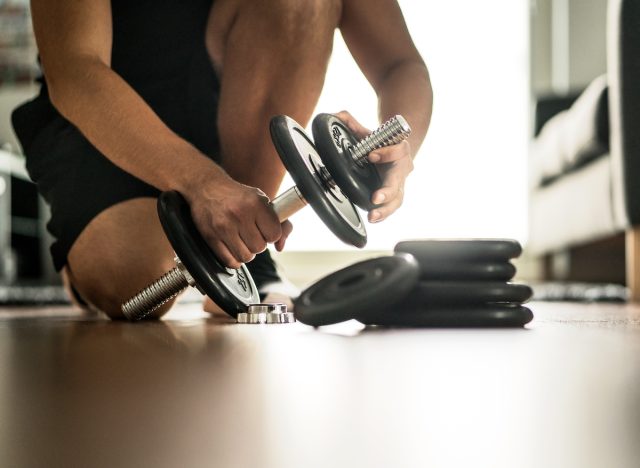
Certified personal trainer Paul Warloski says his favorite weight-loss strategy he recommends to clients is the 3-2-1 approach: three days a week of heavy weight lifting, two days a week of HIIT or Tabata to get your heart rate up, and one day a week of endurance training (like cycling, jogging, or walking)
“This combination has been shown through research and personal experience to be really effective over the long haul to lose weight and keep weight off,” he says.
Whether or not you follow the 3-2-1 method to a T, the important thing to remember is to mix it up. Experts say the ideal exercise regimen will include a combination of both cardio and resistance training. Because even though some cardio workouts may burn more immediate calories than strength training, research indicates that resistance training causes your metabolism to kick into high gear for longer causing you to burn more calories in the long run.
Get your steps in.
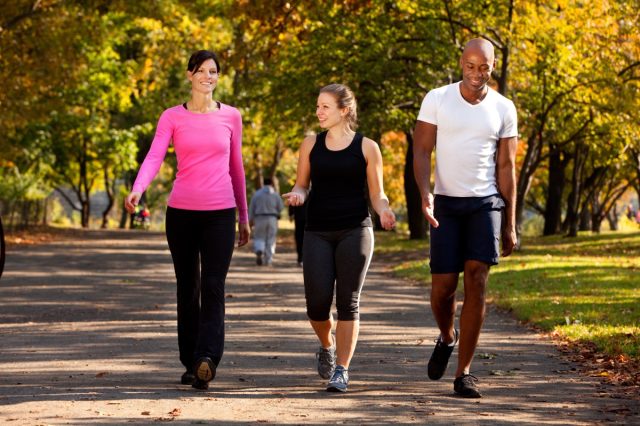
Are you getting 10,000 steps in daily? Whether or not this goal is realistic for you, experts say doing more walking in general—and keeping track of your progress—can go a long way.
“Walking is a free, simple, and low-impact exercise that can bring along many benefits when engaged in daily,” says Christine VanDoren, CN, CPT at SportingSmiles.com. “Among these are increased longevity, weight loss, improved muscular endurance, and prevention of many ailments.”
VanDoren notes that 10,000 steps may seem like a daunting and time-consuming task if your work does not require you to be on your feet. Start with 5,000 steps a day and work up from there. You may be surprised at how the calories burned from those daily walks start to add up!
Don’t do a diet you can’t stick to.

Let’s be real: the problem with a lot of more restrictive diets is that cutting out entire food groups—like carbs, for example—is just not something you can realistically stick to forever. That means that when you inevitably go off the diet, you’re only going to gain back the weight you lost once you introduce those foods. In fact, you may even gain weight from overindulging in the foods you previously deprived yourself of.
That’s why Carli strongly advises staying away from diets that exclude whole food groups. Instead, she recommends getting educated on the nutritional value of different foods. The more you understand how certain foods and their nutrients can impact your energy levels, hunger levels, and metabolism, the more prepared you are to make smart choices that support your weight loss journey.
Eat at least three cups of vegetables a day.
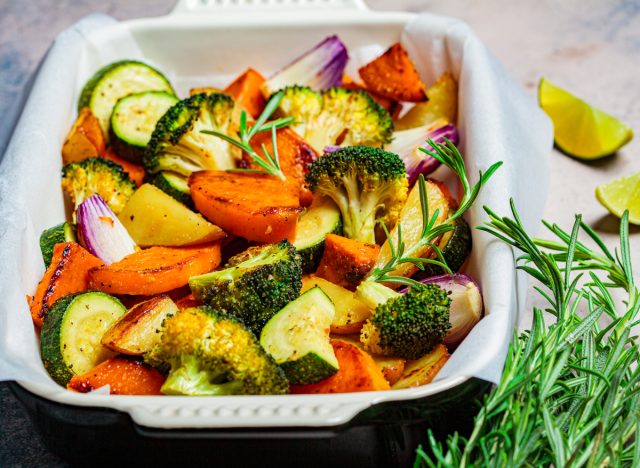
Upping your veggie intake is one habit that’s bound to support weight loss—by filling up on these nutrient-dense, high-fiber foods that also tend to be super low in calories and fat, you’re less likely to overdo it on less healthy options. Specifically, Melody Sayers, MS, RDN, NASM-CPT, advises eating at least three cups of vegetables daily—one cup at each meal.
According to Sayers, diversity is key here. So, challenge yourself to “eat the rainbow” and incorporate a few different kinds of vegetables on your plate, and regularly switch it up when shopping for produce at the grocery store.
“This is because different colored vegetables contain different micronutrients,” says Sayers. “For example, dark green leafy vegetables provide calcium, iron, and Vitamin K, whereas carrots and sweet potatoes are high in Vitamin A.”
As for portion sizes, Sayers says you should aim for a pile of veggies at least the size of your fist at each meal.
Work on mindful eating.
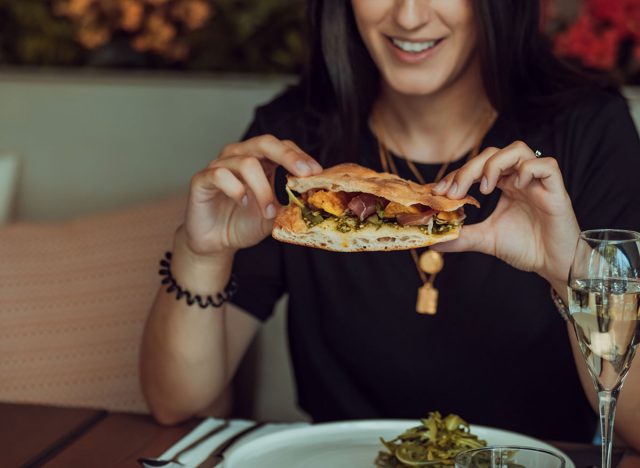
The more aware you are during the experience of eating a meal, the more likely you are to pick up on those cues that you’re full, thus preventing you from overeating. That makes mindfulness an indispensable strategy for weight loss.
“Mindful eating means acknowledging your feelings, thoughts, and bodily sensations surrounding taste, satisfaction, and fullness,” says Sayers. “Mindful eating can help you manage hunger levels, portion sizes, and prevent episodes of stress eating. Before feeling the urge to eat, assess your true hunger levels, slow down your intake, and decipher between physical and emotional hunger.”
Sayers says it’s important to eliminate any distractions while you’re eating. If you’re watching TV or catching up on work emails during a meal, you’re far less likely to recognize when you’re full.
Ricci-Lee Hotz, MS RDN, and expert at Testing.com, recommends taking the time to put your utensil down in between bites of food to slow down the whole experience.
“Focus on taking time at each meal or snack and put your utensil down between bites, really taste and acknowledge the food you are eating, as well as paying attention to hunger cues and fullness cues,” says Hotz.
Since it can take up to 20 minutes for your body to register that you’re full, experts always recommend waiting a little while before going pack for second helpings.
Try the volume eating method.
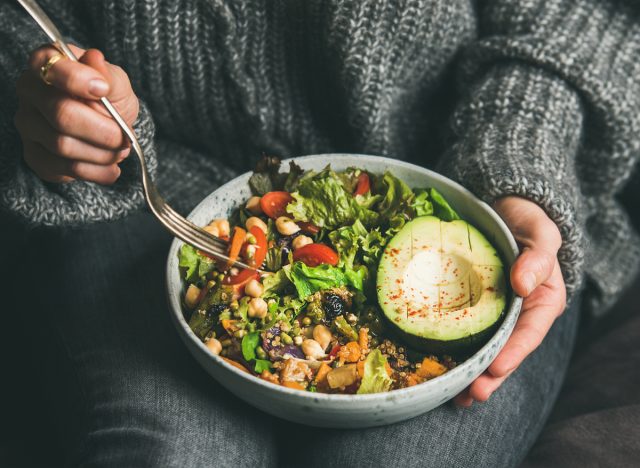
What if we told you that you could eat larger quantities of food while taking in fewer calories and therefore, actually losing weight without ever feeling hungry? Well, that’s the idea behind the “volume eating” approach, which entails prioritizing low-calorie foods that have a high volume to fill you up.
“I’ve been following this diet pattern for a year and have found great success in weight loss and feelings of overall improved wellbeing,” says Trista Best, RD at Balance One Supplements. “My personal experience aside, volume eating can produce weight loss due to increased satiety from meals and lower calorie intake overall.”
To follow volume eating successfully and safely, Best says it’s important to recognize your true hunger and fullness cues and focus more on eating nutrient-dense foods that fill you up on fewer calories—like beans, vegetables, oats, and nonfat yogurt.
Go for a combo of fiber and protein at breakfast.
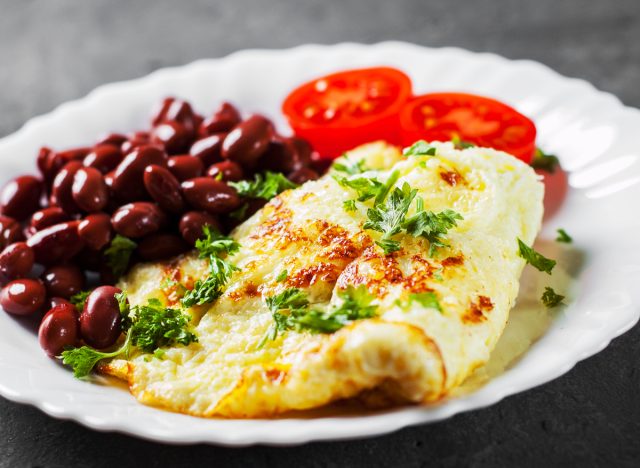
According to Meshulam, a balanced breakfast means having a source of both protein and fiber for maximum satiating power. Having just carbs—for example, cereal, toast, or a bagel—spikes your blood sugar quickly and leads to subsequent crashes, she says.
Instead, start by choosing a fiber-rich carb (like oatmeal or sprouted whole-grain bread) and level it up by adding protein (like nuts, an egg, or nonfat cottage cheese). Ideally, Meshulam recommends aiming for at least 10 grams of protein at breakfast time.
“Eating foods rich in fiber will help to slow down the digestive process and reduce gastric emptying to keep you feeling satisfied for longer and less likely to overeat,” says Morgan Savy, RD and personal trainer at Uplift Food. “This is particularly important when monitoring your overall intake if you are aiming for a calorie deficit. High-fiber foods include legumes and lentils, many vegetables and fruits.”
Have a plan.

“We tend to make better decisions when we don’t make them in the moment,” says Weisenberger.
For this reason, she highly advises planning out your meals and snacks as much as possible. For example:
- Create a list of three to five easy snacks you can always choose from, so you’re not scrambling to eat whatever’s most convenient when you get hungry mid-afternoon.
- On Sunday, meal prep and pre-portion lunches to take to work for the next few days.
- Create a personalized menu for your favorite restaurants that includes wholesome choices.
- Decide before going to a party how many drinks you’ll have and stick to that amount.
- Figure out before you have a holiday meal with relatives what you will say to “food pushers.”
Start small.
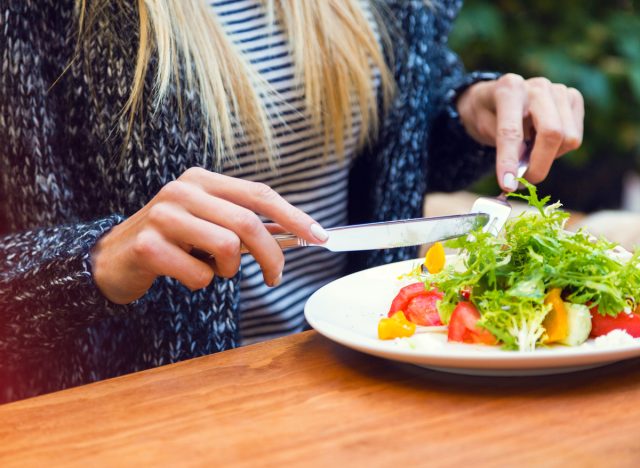
When you make overly ambitious changes, you’re way more likely to “fall off the bandwagon,” which may leave you feeling so discouraged that you abandon your weight loss efforts altogether. Conversely, the Centers for Disease Control & Prevention (CDC) reports that people who lose weight more gradually (just about 1 to 2 pounds per week) are more successful at keeping that weight off for good.
Remember: slow and steady wins the race, and that includes when it comes to slimming down.
“Focus on small, incremental changes that are measurable,” says Supriya Lal.
For instance, instead of telling yourself you’re never allowed any sweets, consider adopting a goal of eating a salad before dinner every night. This small change may help to increase your fullness levels so you don’t even need or want to reach for dessert after. But the point is, it’s a habit you’re more likely to stick to—and that consistency will fuel the motivation you need to keep going with your weight loss journey.
Try counting calories for a month.
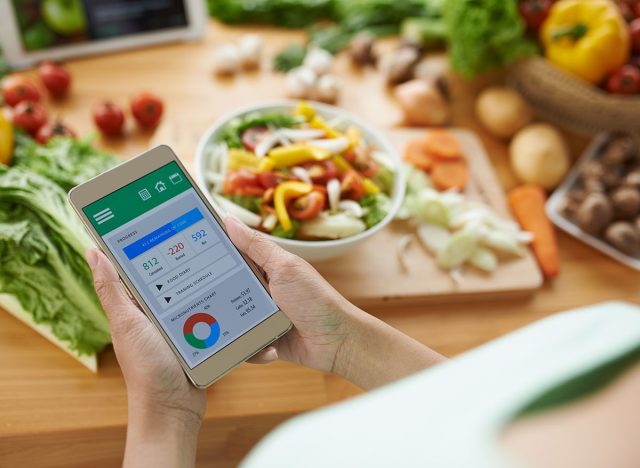
Calorie counting isn’t for everyone . However, experts agree that for some who are trying to lose a specific amount of weight within a particular time frame, especially due to health reasons, it can be a super helpful tool. VanDoren suggests trying it for a month rather than committing to this lifestyle change long-term.
Tracking calories, even temporarily, can give you valuable insight into the energy density of all your favorite foods so you can tweak your intake accordingly to shed pounds.
“If you decide you want to stop calorie counting after one month, that’s totally fine—you now have acquired new knowledge you can use for the future,” says VanDoren.
If counting calories just isn’t your thing, try counting macros instead, says Dr. Christopher McGowan, MD, a gastroenterologist and obesity medicine specialist at WakeMed Health & Hospitals and True You Weight Loss. Dr. McGowan typically recommends following a 30/40/30 regimen (30% protein, 40% carbs, and 30% fat) for weight loss.
Get an annual blood test.
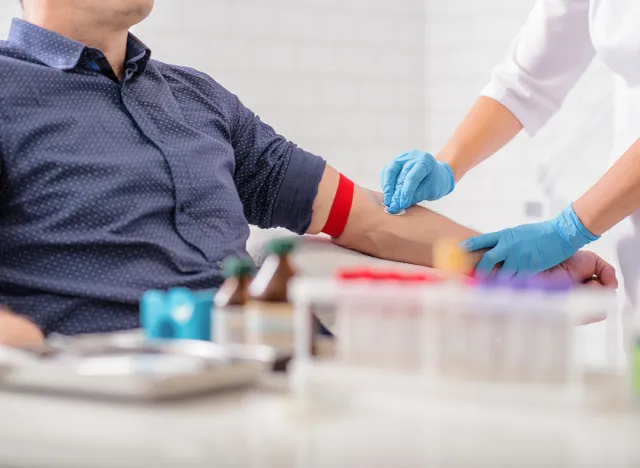
“I always refer to blood test results as a ‘registered dietitian’s report card,'” says Sayers. “So much goes on in the inside of our bodies and sometimes several health conditions don’t yield physical symptoms. You can be of normal weight and still have prediabetes, high cholesterol, or high blood pressure. Blood tests help uncover so much information about the various functions of our organs and assist us health professionals in correcting any discrepancies and deficiencies that may exist.”
Getting a full picture of your current health can help you to fine-tune your weight loss goals and strategies. Experts recommend getting a Comprehensive Metabolic Panel, and if you’ve been rapidly gaining weight or struggling a lot to lose weight, you may want to ask your doctor about blood tests for thyroid function assessment.
Eat every few hours.
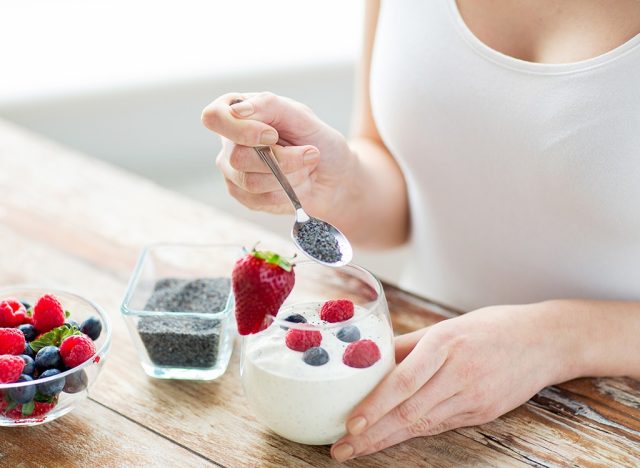
Unless you’re intentionally trying intermittent fasting (and the jury’s still out on whether that’s effective for everyone), going long periods of time between eating can pose a few problems when it comes to weight loss, says Meshulam. For one, you may be more likely to overeat after depriving your body of substance for so long.
“Instead, eating every three to four hours sets most of us up for success by ensuring we keep our blood sugar steady and never getting too hungry,” she explains.
When you know you won’t be able to eat another meal for four or more hours, Meshulam says to make sure to keep healthy nibbles on hand, like yogurt with seeds, an apple and handful of walnuts, celery with almond butter, or hard-boiled eggs.
Skip the artificial sweeteners.

You may think that choosing a sugar-free yogurt, soda, or coffee creamer will help you lose weight — but many experts say they can often do more harm than good.
“Artificial sweeteners can wreak havoc on our guts, increase sugar cravings later on and alter our taste buds to need more and more sweetness to satisfy a craving,” says Meshulam. “All of these can be problematic to weight management.”
Meshulam recommends focusing on weaning yourself off fake sugars and instead, substituting them with small amounts of natural sweeteners. For instance, try using a teaspoon of honey in your tea rather than two packets of Splenda.
Seek out viscous fiber.
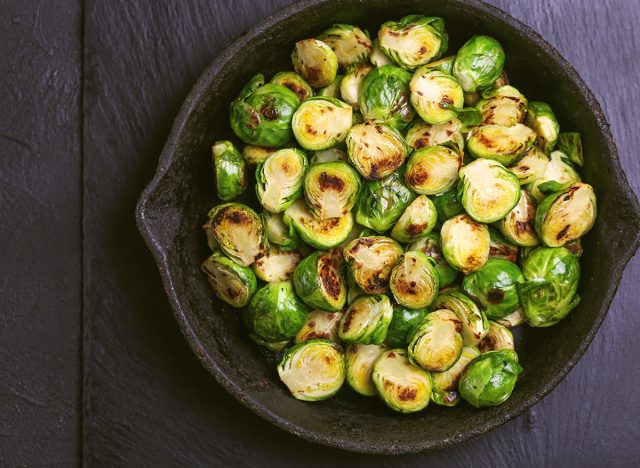
Certain types of soluble fibers—known as viscous fibers—form a thick gel-like substance when they blend with water that slows down digestion so you feel fuller longer, says Clair. In fact, a 2013 review in the Journal of the American College of Nutrition found that viscous fibers were the only type shown to reduce food intake and support weight loss.
According to Clair, some of the richest food sources of viscous fiber include asparagus, Brussels sprouts, sweet potatoes, turnips, apricots, mangoes, oranges, legumes, barley, and oat bran.
Speaking of fiber, Kara Landau, RD, gut health expert, and founder of Uplift Food, notes that resistance starch is another type of fiber to focus on. True to its name, this type of starch is resistant to digestion and is known for lowering blood sugar as well as reducing your appetite.
“Consuming resistant starch is a great tool for weight loss because it increases your body’s response to insulin, which helps to manage the amount of fat our body stores, and also improves gut health to aid digestion and reduce bloating,” she explains.
Foods that are high in resistant starch include green bananas, beans and legumes, raw oats, and potatoes that have been cooled down after cooking.
Have an accountability buddy.

Sharing your goals with a friend, family member, doctor, or even in a journal can help hold you accountable, says Lal—thus increasing the odds that you stick with your weight loss plan.
“Documenting what you eat, when you eat, and how you feel can have a really significant impact on your ability to lose weight, and you won’t have to do it every day, forever,” adds McGowan. “When you’re starting a weight loss journey it can help you identify where you’re getting the most calories, which foods keep you full for longer, and when and why you may be eating—whether out of boredom, in response to emotions, or because of legitimate hunger. When you start journaling and documenting your food intake, you’ll gain a better understanding of healthy portion sizes that will help you maintain good habits over time.”
You may even want to make a pact to share your progress or work out with a friend on a weekly basis. That way, you can celebrate small wins so you feel more motivated along the way.
“When working out with others it can be easier to push yourself and do things that you don’t want to do,” adds Mentus. “It also helps you to stay accountable and not cancel if others are expecting you to join them at a particular time. Consistency and effort are essential to losing weight and both of these will be improved by working out with the right people.”
Find a form of exercise you actually enjoy.
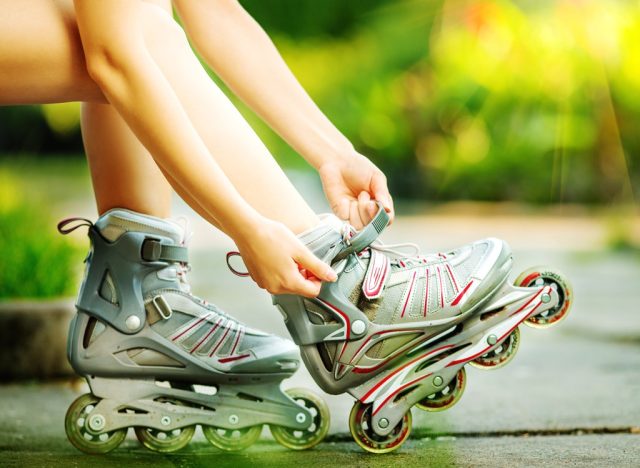
The CDC recommends that adults get at least 150 minutes of exercise each week. That may sound like a lot, but experts say the secret to meeting this requirement is finding an activity you can actually look forward to and enjoy. So, if you dread hopping on the treadmill or doing HIIT sessions, try something fun and different—like a dance class, rollerblading, aerial yoga, shooting hoops, or swimming laps.
“When you participate in something that you enjoy, you are more likely to get up and do it,” explains Sayers.
Sayers highly recommends using a heart rate monitoring device while you work out. Ideally, the CDC suggests getting your heart rate in the moderate zone during aerobic activity, which means a target heart rate between 64% and 76% of your maximum heart rate. You can estimate your maximum age-related heart rate based on your age by subtracting your age from 220. Pro tip: If you can talk while you are exercising but you’re too out of breath to sing full lyrics then you’re in the moderate zone.
Figure out your basal metabolic rate.

As you probably know by now, a calorie deficit is the one surefire way to lose weight. But in order to create the deficit, you’ll first need to calculate your basal metabolic rate (BMR)—or the number of calories your body burns at rest simply to stay alive.
“It can also be thought of as the number of calories you would burn if you just sat in a room and didn’t move at all,” explains McGowan. “Simply put, knowing your BMR can help you determine the number of calories you can consume on a daily basis without gaining weight. It’s expressed as the number of calories burned per unit of time, and is most often measured by the number of calories burned per day.”
Knowing your BMR will help you adjust your meal planning and target daily calorie intake accordingly. There are a number of different factors that can impact your BMR, including your age, sex, height, weight, and even the percentage of muscle in your body. Fortunately, there are a number of online BMR calculators you can use to figure yours out.
For even more weight loss tips, read these next:
